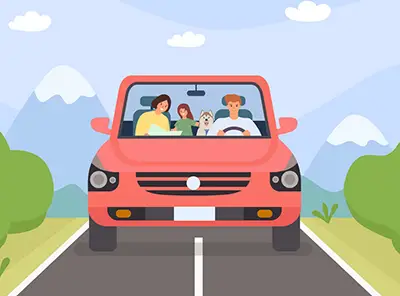Tips on Driving Safely with a Pet
 Most pet owners confess a road trip is not much fun if their pets cannot tag along. For those who don’t have much experience, the biggest challenge is car driving with your pet. Is it okay to travel with your pet halfway across the country? Will the pet get road fatigue? Will the pet cause an unnecessary distraction? What are the special needs of your pet? Such questions should be asked by drivers who want to car-travel with their pets especially on a long-distance trip. Well, it is not that complicated as long as you familiarize yourself with how to drive safely with a pet.
Most pet owners confess a road trip is not much fun if their pets cannot tag along. For those who don’t have much experience, the biggest challenge is car driving with your pet. Is it okay to travel with your pet halfway across the country? Will the pet get road fatigue? Will the pet cause an unnecessary distraction? What are the special needs of your pet? Such questions should be asked by drivers who want to car-travel with their pets especially on a long-distance trip. Well, it is not that complicated as long as you familiarize yourself with how to drive safely with a pet.
Before the trip
Whether you have a dog or a cat, there are certain essentials that you require to pack for your trip. The top item on the list should be a well-ventilated carrier or crate with a harness. Make sure the crate is big enough for the pet to sit, stand and turn around. The next step is taking your pet on a series of short trips before the eventual expedition. Pets tend to get anxious when engaged in a first-time activity like being locked in a carrier and driven in a car. If possible, ask a friend or a family member to sit next to the pet to cuddle and calm it down if it gets too nervous. Eventually, the pet will get used to being driven around in a car. Of course, you will also need to pack extra materials such as odor/stain remover, poop bags, water, snacks, pet first aid kit, blankets, pillow, recommended vet medication, and seat cover. Feed your pet a light meal 3 or 4 hours before traveling. A pet on a full stomach mixed with the speed of a car could turn out to be a bad combination causing the pet to vomit or constipate. Before commencing the trip, encourage your pet to visit the toilet and exercise for a few minutes.
On the road
Never make the mistake of letting your pet sit on your lap while driving. Distracted driving is one of the leading causes of accidents and who says your pet can’t misbehave distracting your attention on the road. The ideal place to position your pet is on the backseat harnessed to its crate or carrier. The carrier should be tightened behind the driver’s or passenger seat. This is to reduce the motion impact of the crate or carrier in case of an emergency. Furthermore, your pet is likely to be critically injured with an airbag on the front passenger seat than on the backseat. For dog owners, it probably seems okay for dogs especially in the movies to stick their bodies outside the windows. But did you know a dog is more likely to develop eyes problem by doing that? Blame it on the highway debris plus too much wind can irritate the mucous membrane which is connected with the eyes. Allowing a pet to ride in the back of an open pick-up truck is also considered risky. If you love your pet, you would not take chances knowing at least 100,000 dogs die every year while riding on the back of an open truck. A toy would be helpful on a long trip to keep your pet engaged especially a dog or a cat. You can make a pit stop once in a while to feed your pet and let it play before getting back on the road. A 15-minute break once every 2 hours is recommended.
During a roadside stop-over
Once parked, do not leave your pet inside the vehicle. On a hot sunny day, the temperature inside a parked car can be twice as much as outside in a span of few minutes. For instance, it only takes at least 10 minutes for a car to reach 120 degrees Fahrenheit inside while outside it is 100 degrees Fahrenheit. In some parts, just a 15-minute coffee break is enough to cause a heat-stroke to your pet if left out inside the car. There are even cases of pets freezing to death after owners left them in the car for a short break outside during winter. If you are afraid of losing your pet on the road, a microchip will make it easier to trace it. Don’t forget to include your cellphone number or any other relevant information on the collar or microchip tag.
There are provinces that will require proof of your pet’s vaccination records and license information. Just for precaution purposes, carry the necessary documents and make sure your pet status is up to date with the vaccination. For pets that keep getting car sick despite going out for numerous trips, a visit to the vet is recommended. Not all pets were meant to be driven around in a car but the majority can handle it without too much sweat.
